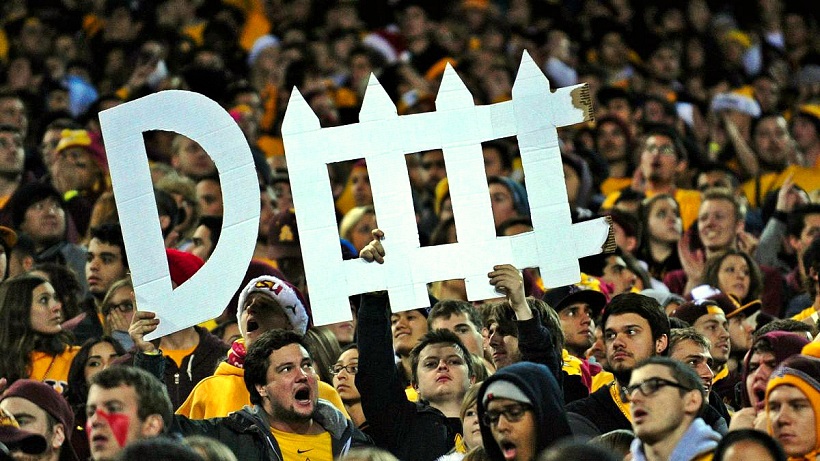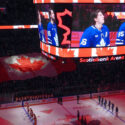TORONTO (Feb. 10) — Having completed two–thirds of the regular season, it appears as if the Toronto Maple Leafs are cloaked in something inexplicable. How can a team bloated with such outlandish skill remain on the fringe of Stanley Cup playoff contention nearing mid–February? I’ll reply to the question, unequivocally, with another question: Is there a hockey club that can achieve soaring expectation in the near–absence of defensive posture? The straightforward, uncomplicated answer: Absolutely not.
Neither must we look more deeply to interpret or justify the longest current Stanley Cup drought (nearly 52 seasons). Since 1967, and with very brief exception, the Maple Leafs have been a defensive laughingstock. Even today, with their sub–standard 29–19–8 record after 56 games, the mystery is negligible. Toronto has yielded 187 goals — more than only bottom–feeders Ottawa, New Jersey and Detroit — for an average of 3.34 per game. Having scored 200 goals, the club is merely a plus–13, miles beneath Atlantic Division leaders Boston (plus–45) and Tampa Bay (plus–49). Virtually every year, it’s the same story: the Leafs have enough talent up front and in goal to contend… yet barely a clue how to perform without the puck, especially in the defensive zone. Isn’t that the barefaced truth? Why, then, should we consider the 2019–20 Maple Leafs to be underachieving? Perhaps the club has over–achieved, given its inability (or unwillingness) to limit shots–on–goal and scoring opportunities. And, it begs the eternal Maple Leafs question: If defense, rather than puck–skill, can be taught, why have decades of Toronto teams failed to grasp that essential part of the game?

In my view, and I doubt I’m alone, the answer rests more with desire than ignorance. It’s difficult to fathom that only Roger Neilson and Pat Burns (among 22 head coaches since Punch Imlach) have, for a time, been able to deliver the message. Under no circumstance were the other 20 coaches lacking in defensive wisdom. Yet, Neilson and Burns were the lone mentors to achieve a measure of success… and, not surprisingly, guide three of the five Stanley Cup semi–finalists since 1967. The other two belong to Pat Quinn, whose philosophy was to run and gun while being saved by your goalie. It nearly worked, twice, with Curtis Joseph. Otherwise, hockey hasn’t changed since the 1940’s. The last teams standing are, invariably, those that perform best on their side of the center red–line. Which the Leafs never do over the span of more than a few games.
Remarkably, there are fans and media that believe this can be reversed with the addition of a single, accomplished defenseman prior to the Feb. 24 National Hockey League trade deadline. That one player can reshape an entire club. It will not happen; neither the coveted acquisition nor the instant transformation.
The only hope for the Leafs — squeezed up against the salary cap with four players of similar dimension hoarding nearly 50 percent of the allotment — is that the overwhelming majority of skaters (defensemen and forwards) apply themselves as diligently without the puck as when sniffing a scoring chance. Which, again, no coach in more than a quarter–century has successfully prevailed over the Blue and White.
Neither will any other recourse stand the club a plausible chance to nail down a playoff berth… and virtually any chance of advancing beyond either Tampa Bay or Boston in the opening round.
For the Leafs, it is always rinse, and repeat.
EMAIL: HOWARDLBERGER@GMAIL.COM




































This piece touches on something I’ve realized for a while. It’s something which seems baked in to the very fiber of the franchise and it is this…EVERY Leaf team for the last 40+ years which found “some” success was a team that was more or less together from the beginning of that succesful run. It has never been a team that started out together and continually improved into similar playoff success…NEVER. The early 90’s team took off virtually the moment Doug Gilmour arrived. That was the real turning point. The other succesful era began with the signing of Curtis Joseph. The Leafs where a completely different team in both eras after those 2 players came to town. Now search your brain for an example of a Leaf roster being mostly together from the start which incrementally improved and went on to any meaningful playoff success. Some would argue that the teams of the mid or late 1970’s fit that description, but those teams where led by a core quite a bit older (ie Sittler, Salming, McDonald) then the one we see today. I don’t know exactly what it is, but there is just something about the Toronto market itself that hinders things. After 52 years of players, managers, coaches, owners coming and going the market is the only thing that has remained. Unless you want to believe that all those skilled and accomplished people somehow lose all their abilities the moment they land in Toronto only to discover it again the moment they leave town… voluntarily or otherwise. Seems unlikely.
I also share your opinion, Howard. I feel the message has to come from the players themselves or from Shanahan. With Toronto teetering on the rim of the abyss I’d like to see Shanahan pull a coaching 101 move by holding a team meeting, dropping his 3 rings on a table and telling the players what it takes to win.
To plagiarize your pal Simmons “Yzerman was a star unlike few before him: In the years prior to Bowman coaching the Detroit Red Wings, he had scored 65 goals, 62, 58, 51 and 50. Only Mario Lemieux had more goals in that time period. Only Wayne Gretzky and Lemieux had more points. “I said to him: ‘You’ve got to play a lot differently if this team is going to win,’ ” said Bowman, describing the extreme challenge in Ken Dryden’s book Scotty: A Hockey Life Like No Other.
I believe you are totally correct in saying that it is a failure to buy in rather than an inability of the defense. For me a large step forward would be that if the forwards would slow down the opposing players in the defensive zone as opposed just play the angles and gaps. Engaging the opposition physically is part of hockey.
You nailed it. Great writing and analysis. Thanks for cutting through the noise and boiling it down to the simple truth.